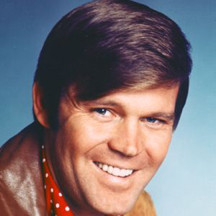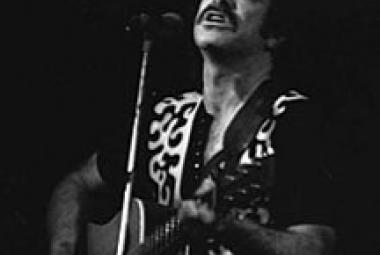Glen Campbell (born April 22, 1936) is an American country music singer, guitarist, television host, and occasional actor. He is best known for a series of hits in the 1960’s and 1970’s, and for hosting a variety show called The Glen Campbell Goodtime Hour on CBS television. During his 50 years in show business, Campbell has released more than 70 albums. He has sold 45 million records and accumulated 12 RIAA Gold albums, 4 Platinum albums and 1 Double-Platinum album. He has placed a total of 80 different songs on either the Billboard Country Chart, Billboard Hot 100, and/or the Adult Contemporary Chart, of which 29 made the Top 10 and of which nine reached number one on at least one of those charts. Campbell made history in 1967 by winning four Grammys total, in the country and pop categories. Campbell won the Grammy Lifetime Achievement Award in 2012. (More from Wikipedia)
During the tributes to Glen Campbell at this year’s Grammy Awards and Academy Awards, it occurred to me that I am more of a country music fan than I usually let on to other people – or even to myself. Besides the June 2012 concert appearance by the Flaming Lips as part of their mini-tour to set the Guinness World Record for the largest number of concerts in a 24-hour period (and travelling by bus no less), the only live concerts that I have been to in the past four (maybe five) years are the “Queen of Rockabilly” Wanda Jackson in February 2013 and Glen Campbell in August 2011. The latter concert was at the IP Casino in Biloxi after he publicly acknowledged being afflicted with Alzheimer’s Disease and was a warm-up concert for Glen Campbell’s Goodbye Tour, which extended from August 31, 2011 through November 30, 2012. Part of the intention of the Goodbye Tour was to help ease the social stigma associated with Alzheimer’s and other forms of dementia.
I don’t really think of Glen Campbell as a country artist, although everyone else on Earth does, so it must be true. I suppose I would describe him as a folk-country, singer-songwriter – but country makes a good shorthand.
* * *
Glen Campbell was born in 1936 to a share-cropper family in rural Arkansas, the 7th out of 12 children. He was taught guitar at a young age by his uncle Bob; and in 1954, he joined his uncle’s band that was known as Dick Bills and the Sandia Mountain Boys. His uncle had a radio show as well; and Glen also appeared on a children’s program, K Circle B Time, on KOB-TV. In 1958, Campbell started his own band, the Western Wranglers.
In 1960, he moved to Los Angeles to become a session guitarist. At about the same time, Glen Campbell also joined the Champs, which had a Number One hit in 1958 with “Tequila”. The song was written by bandmember and saxophone player Danny Flores, known as the “godfather of Latino rock”.
Glen Campbell quickly became highly sought after as a guitarist and played for a wide variety of artists in the 1960’s; Wikipedia lists recordings by Bobby Darin, Rick Nelson, Dean Martin, Nat King Cole, the Monkees, Nancy Sinatra, Merle Haggard, Jan & Dean, Elvis Presley, and Frank Sinatra.
* * *
Glen Campbell was part of a loose aggregation of dozens of session musicians who performed more or less anonymously on countless hit songs, primarily in the 1960’s and 1970’s. They came from a variety of backgrounds but were typically professionally trained musicians in jazz or classical music.
Drummer Hal Blaine dubbed the group the Wrecking Crew; Wikipedia says: “According to Blaine, the name ‘The Wrecking Crew’ was derived from the impression that he and the younger studio musicians made on the business’s older generation, who felt that they were going to wreck the music industry.” Wikipedia lists an almost completely different group of artists in that article (as opposed to those listed above who were backed by Glen Campbell in particular): “Notable artists employing the Wrecking Crew’s talents included Nancy Sinatra, Bobby Vee, the Partridge Family, the Mamas and the Papas, the Carpenters, the 5th Dimension, John Denver, the Beach Boys, Simon and Garfunkel, the Grass Roots, and Nat King Cole.”
The statistics about the Wrecking Crew are staggering, with various members appearing on tens of thousands of recordings. Hal Blaine is believed to be the most recorded drummer in history, while Tommy Tedesco is said to be the most recorded guitarist. From Wikipedia: “Blaine is credited with having played on at least forty U.S. #1 hits and more than 150 Top Ten records.” And their talents were not limited to records; again from Wikipedia: “Tedesco’s credits include the iconic brand-burning accompaniment theme from television’s Bonanza, The Twilight Zone, Vic Mizzy’s iconic theme from Green Acres, M*A*S*H, Batman, and Elvis Presley’s ’68 Comeback Special.”
Hal Blaine and another drummer Earl Palmer were the first Sidemen inductees in the Rock and Roll Hall of Fame in 2000; the entire Wrecking Crew was inducted into the Musicians Hall of Fame in 2007. Wrecking Crew musicians formed the house band for the early concert film, The T.A.M.I. Show (1964); Glen Campbell can be seen in a few shots.
* * *
Superstar record producer Phil Spector used members of the Wrecking Crew to create his famed “Wall of Sound”; while Beach Boys bandleader Brian Wilson used these musicians on their acclaimed Pet Sounds album and their Number One hit “Good Vibrations”.
* * *
One of the first successful female session musicians is bass guitarist and guitarist Carol Kaye; she preferred the name “the Clique” to the Wrecking Crew, and she is credited with appearing on 10,000 recordings. Kaye once commented that at her peak, she was earning more money than the President. Wikipedia reports: “Her intense solo bass line, reverberating in quiet moments in [Phil] Spector’s production of [Ike and Tina Turner’s] ‘River Deep, Mountain High’, lent drama to the song’s ‘Wall of Sound’ and helped lift the record into the Grammy Hall of Fame.” Her work for Quincy Jones so impressed him that, in his 2001 autobiography Q, he wrote (as quoted in Wikipedia): “. . . women like . . . Fender bass player Carol Kaye . . . could do anything and leave men in the dust.”
Besides Glen Campbell, several members of the Wrecking Crew went on to great prominence in the music world, among them Mac Rebennack (better known as Dr. John) and Leon Russell. This time the Wikipedia quote is from one of my own contributions: “Also, Nino Tempo with his sister Carol (under her stage name April Stevens) had a U.S. #1 hit song in 1963, ‘Deep Purple’.” The song was originally a big-band hit in the 1930’s and a top seller in sheet music back when this was a more important component of the music industry; the music was written by pianist Peter DeRose in 1933, with lyrics added five years later by Mitchell Parish. The name of the British rock band Deep Purple was suggested by guitarist Ritchie Blackmore because “Deep Purple” was his grandmother’s favorite song; she used to play the song for him frequently on the piano.
* * *
Glen Campbell is of course best known for his long string of hit songs in the 1960’s and 1970’s – beginning with the John Hartford song “Gentle on My Mind” in 1967 – and his many television appearances on such shows as The Smothers Brothers Comedy Hour and his own The Glen Campbell Goodtime Hour (from January 1969 to June 1972). Adding interest to his appeal to me, there was a guy in my dorm when I first got to college at North Carolina State University who was the spitting image of Glen Campbell; he was frequently greeted with “Hey Glen” and even had the same smile.
His old friends from the Wrecking Crew lent a hand on several of his records; for instance (from Wikipedia): “[Carol Kaye] also came up with the famous intro on Glen Campbell’s greatest hit ‘Wichita Lineman’.” I have collected numerous albums by Glen Campbell over the years, and they are all first-rate from beginning to end.
Besides his long hit-making career and the requisite accolades – such as four Grammy Awards, three Grammy Hall of Fame Awards, and his induction into the Country Music Hall of Fame in 2005 – Glen Campbell also appeared in several major films, most famously the John Wayne movie True Grit (1969) that earned Campbell a Golden Globe nomination for Most Promising Newcomer.
* * *
But the real reason that I wanted to see Glen Campbell live when I got the chance was to see his prowess on the guitar, and I was certainly not disappointed. Before he started making hits, Campbell had released several albums of guitar music; the only times that I have ever seen them are in small pictures on his earliest hit albums, such as The Astounding 12-String Guitar of Glen Campbell. However, guitar solos are rare and short even on hard rock singles, never mind hit songs by someone like Glen Campbell.
Glen Campbell’s backing band at the concert that I saw were all or almost all members of his extended family, including several of his children. Campbell occasionally lost his place in the song lyrics and had to be repeatedly reminded of which song came next and how to start that song. But once he was on, he was on: Those fingers flew up and down the fretboard in breath-taking displays of virtuosity.
* * *
The truly heartbreaking part of his Alzheimer’s diagnosis is that Glen Campbell had just launched a comeback a few years before, with his 2008 album Meet Glen Campbell that features Campbell covering songs by U2, Foo Fighters, Tom Petty, and Green Day – “Good Riddance (Time of Your Life)” being the latter song – plus one of the last songs written by John Lennon, “Grow Old with Me”, and an early Jackson Browne song, “These Days” that was first recorded by Nico in 1967.
* * *
Ghost on the Canvas was intended to be Glen Campbell’s last studio album and was released on the eve of Glen Campbell’s Goodbye Tour. Instead, a documentary directed by James Keach that was made during the Goodbye Tour came out in September 2014, called Glen Campbell: I’ll Be Me. With co-writer Julian Raymond, Glen Campbell won a Grammy Award for writing and performing the theme song of the film, “I’m Not Gonna Miss You”; and the song was also nominated for an Academy Award. By the 2015 award season, Glen Campbell was too sick to make public appearances and is now in an assisted-living facility. Tim McGraw performed “I’m Not Gonna Miss You” at the 2015 Academy Awards.
As suggested by the title, “I’m Not Gonna Miss You” is about the impact of Alzheimer’s on Glen Campbell’s own life and the lives of those he loves; the song begins:
I’m still here, but yet I’m gone
I don’t play guitar or sing my songs
They never defined who I am
The man that loves you ’til the end
You’re the last person I will love
You’re the last face I will recall
And best of all, I’m not gonna miss you
Not gonna miss you
* * *
Apropos of this discussion, Julianne Moore won the Academy Award for Best Actress for her portrayal of a real-life woman with early-onset Alzheimer’s in the film Still Alice. Her acceptance speech was one of the highlights of the telecast of the Oscars this month; in part she said: “I’m so happy – I’m thrilled actually that we were able to hopefully shine a light on Alzheimer’s disease. So many people with this disease feel isolated and marginalized, and one of the wonderful things about movies is it makes us feel seen and not alone. And people with Alzheimer’s deserve to be seen, so that we can find a cure.”
In his acceptance speech for the Academy Award for Best Supporting Actor, J. K. Simmons urged: “Call your mom, call your dad. If you’re lucky enough to have a parent or two alive on this planet, call ’em. Don’t text. Don’t email. Call them on the phone. Tell ’em you love ’em, and thank them, and listen to them for as long as they want to talk to you.”
To me though, people with Alzheimer’s deserve to be seen and heard not just to help push for a cure – that will certainly help the rest of us, but not those already afflicted. I would go further than these fine actors and say that you should reach out especially to your loved ones who have dementia or who are otherwise slower than they used to be. Some of the talking out of their head might simply be dreams that they had – and we all have crazy dreams. A little patience with them – say, when they tell the same story over and over – will richly reward not only their lives but yours as well. I treasure the times that I spent with my grandmother Alma T. Nowell, who lived practically across the street from us when I was a kid.
About four years after the death of my father Wallace M. Winfree, my mother Flora N. Winfree now needs a higher level of care at Brookridge Retirement Community following a scary incident about a year ago; and my brother Tom S. Winfree and sisters Alison W. Pickrell and Julie W. Kovasckitz cleaned out the apartment that my parents shared at Brookridge on the last day of February 2015. We were initially worried that some of the residents in that section who were much worse off than my mother would bring her down; instead, I hear that she enjoys entertaining them, and Mom has seemed more animated in my recent conversations with her.















